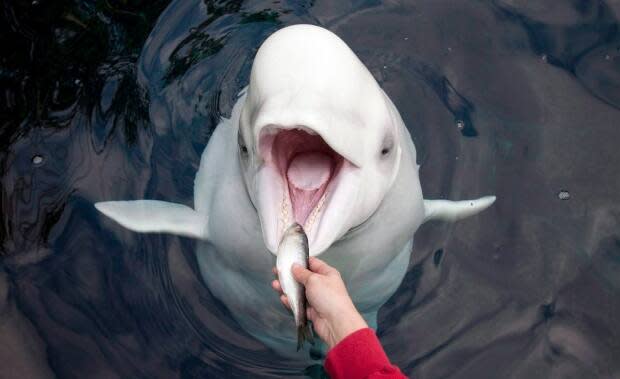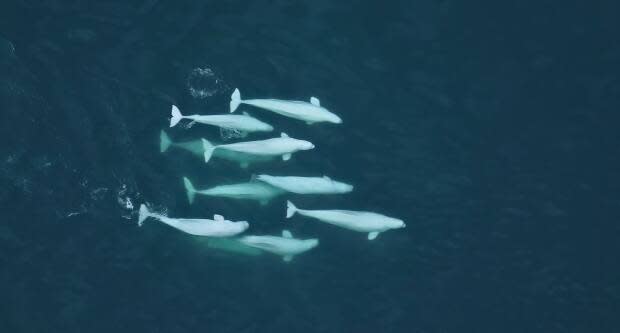'Reality check' needed as N.S. whale sanctuary project coasts ahead

When Charles Vinick describes the proposed ocean home in Nova Scotia for whales that have been in captivity, it sounds idyllic, peaceful, wholesome.
"It's a natural sea bottom, there'll be critters for them to explore, with crabs on the bottom, birds to chase on the sea surface and the like. It's a really enriching environment for them and much healthier than anything they've experienced before."
Contrast that with the ambiance that's typical of marine parks, where the whales would be retired from: a restrictive glass tank, thick concrete walls, humans constantly gawking, pointing and shouting at them.
If Vinick's proposed Whale Sanctuary Project comes to fruition, the $15-million US endeavour would bring beluga or orca whales that have been living in captivity to Port Hilford, N.S., to live out the rest of their lives in an ocean enclosure.
The project recently secured an agreement to purchase land next to the proposed sanctuary from a private landowner, and is slowly wending its way through the provincial and federal regulatory hurdles.

And while community support for the venture is strong in an area of the province that has typically struggled more than others to attract tourists, at least one marine researcher is throwing a bit of cold water on the idea.
Andrew Trites, the director of the University of British Columbia's Marine Mammal Research Unit, says there is a need for such a sanctuary, but raises logistical, budgetary and even animal welfare concerns.
"I am supportive," he says, "but I think everybody has to have their eyes wide open. And when I hear things only said in very rosy terms, I think we should also have a reality check."
About the project
The 44-hectare site near Sherbrooke — chosen for its depth, water flow, tides, lack of ice cover, and community support — would house about eight beluga or orca whales, though the two species would not live together.
Although the Whale Sanctuary Project does not yet have an agreement with a marine park to transfer any animals, Vinick says staff are having conversations about that. The whales would be transported to Nova Scotia in a tank aboard a ship, truck or plane, depending on where they came from, and would arrive in pairs so they have a companion they're used to living with.
Their new ocean home would be about 300 times bigger than the largest performance tank, Vinick says, and would be an average of 10 metres deep, reaching 18 metres in some places.

The whales would be kept in the enclosure with nets that are held to the surface with large buoys and to the sea floor with a heavy chain and anchors.
Since most whales in captivity do not have the skills to survive on their own in the wild, they would remain in the sanctuary for the rest of their lives, which in the case of the beluga can be 50 or 60 years, and even longer for orcas.
Vinick says all funding for the project will come from donations, and the group has already raised millions, though he declined to specify a number.
The public would be permitted to see the whales from a viewing platform, but Vinick says the whales would not be required to perform, and he does not anticipate charging a fee for visitors.

For Vinick, who has spent most of his career managing ocean-related organizations and businesses, the Whale Sanctuary Project is a dream rooted in compassion and respect.
"These whales have entertained tens of millions of people. They have earned hundreds of millions of dollars for the people who have them in captivity. This is the least we can do in giving them back some of the life and dignity that they have as a species," he says.
"You spend time in the wild with whales and you can't help but realize how intelligent, how connected they are to one another as families. And then you see them in captivity, and the difference is so stark and startling."
Animal welfare, financial concerns
Although Trites acknowledges that there would be benefits for the whales to be in a natural environment, he also worries about how the animals would adapt to their new life.
As a researcher, he has studied marine mammal ecology, nutrition, physiology and behaviour. He says in the wild, whales spend most of their time looking for food and watching out for predators, so they're mentally stimulated.
"The one risk for animals that are in confined spaces, even a space as big as the bay, is that they get bored.… The reality is that they'll become lethargic and essentially become like a couch potato, just lying and hardly moving because all you're waiting for is the next meal."
In addition to the potential for suffering from depression, whales can also exhibit aggression if their natural mating instincts are suppressed, Trites says.

Vinick says staff would provide "enrichment" programs for the whales, and they would be stimulated by the dynamic marine environment. He says he doesn't know yet whether the animals would be all male or female, or a mix, but that there would be no breeding.
Trites also questions the financial footings of a project that relies strictly on donations.
"Donors can be fickle," he says. "What often happens with these things is it's the same ask year after year after year and people become numb to it."
Trites learned the consequences of that the hard way. He had a small research facility in Port Moody, B.C., that kept four sea lions, but when COVID-19 hit, donors' funding priorities shifted and he had to close it down.
"In our case, we had a home to send the animals to. But had we not had that, we would have been in a terrible situation."

Trites points to the many expenses associated with operating a facility with live animals, including food, veterinarians, staff, security and trainers, and in the case of the whale sanctuary, keeping the nets clean to ensure good water flow.
"I don't know if they have a true appreciation for just how expensive it is," he says. "I suspect at the end of the day, it'll be taxpayers that will have to fund it. And that may be not what people signed up for."
Vinick estimates the yearly operating costs will be about $2 million, but he maintains the group will not look for government money.

That's reassuring for Beulah Malloy, councillor for the Municipality of the District of St. Mary's.
"It's going to cost a lot of money to do this project, and we have to be assured that the funding's going to be there," she says. "Because if the funding wasn't there, if something happened, like, my concern is, well, then what's going to happen to the whales?"
Malloy says generally, residents are supportive of the project, both because they like the idea of giving whales a more natural place to live and because they see it as a potential boost for the local economy.
What's next for the project?
The Whale Sanctuary Project has submitted its application for a Crown land lease through the provincial Lands and Forestry Department. The project will require consultations, research and a federal and provincial environmental assessment.
The group has already done studies of hydrodynamics, water chemistry and plankton, and is not aware of any potential negative environmental impact from the project, Vinick says.
Local fishermen have agreed to give the project exclusive use of the waters and the wharf in the area.
Next month, the group plans to open a welcome centre in Sherbrooke to share information about whales and the project.
MORE TOP STORIES

